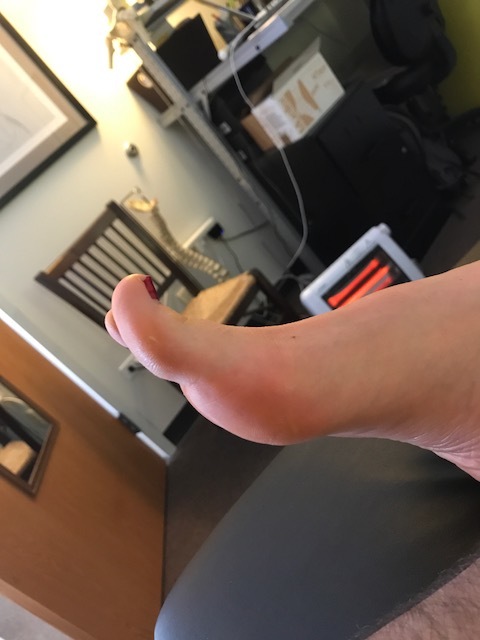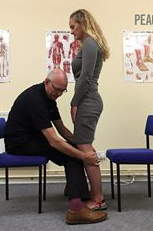What is happening at the 150 meter mark in a 200m sprint when that glute starts to fatigue ? What is happening at the 12th mile in a half marathon when stabilzation around that knee starts to falter?
In this article below, the authors discuss postural adaptations to unilateral hip muscle fatigue. This study merely looks at the effects during standing, so imagine what happens during locomotion when things start to fatigue.
Anyone who has sprained an ankle or banged up a knee knows what it is like to have an automated limping gait. The CNS is trying to reduce and shorten the loading response (and time) on the affected limb. This scenario goes on for awhile, days, maybe weeks, until it becomes somewhat more automated.
We just saw a client in the office just yesterday who had a subtle limp from a foot fracture 6 months ago. I mentioned it in passing, "isn't it amazing that your CNS can still be generating that limping adaptive gait even after 6 months, even now that the pain is no longer present?" His response, "What ? I am still limping? No I'm not ! Am I? Really?" I showed him the video, he was shocked. Things get automated, the CNS adapts, and it often doesn't know when to let go of an adaptive pattern even when it is no longer warrented. It is amazing to think that the brain often cannot logically process the incoming data and revert back to the sensory-motor program that was engaged pre-injury. Amazingly, perhaps the brain still knows better, perhaps it knows that things might seem fine, but lurking beneath the surface the sensory receptors are still sending soft warning signs that things still are not kosher.
We say something like this often to our clients, "The CNS makes momentary adaptive choices, but it has no way of foreseeing the consequences of an adaptive measure which is necessary in the moment. It makes these choices based on perceived stability, necessary mobility, economy, and pain avoidance, most of the time. But, it has no way of seeing into the future to see whether its choices have ramifications, it just chooses what makes the most sense in that moment." This is one of the reasons why we get so cranky about people who offer training and corrective exercise queues to people without deep thought, examination, and consideration. There can be ramifications down the road, that, in the present, are unseen and unknown. For example, just because you are running faster because you altered or augmented a client's arm swing, doesn't mean that newly trained pattern, that might even have the positive performance outcomes, won't have consequences that need to be walked back in the future. This is one of the premises of our recent arguments with the HOF (Head over Foot) crowd, who explicitly convey they only care about the clock and a client's speed, not about their well being down the road. There is no free lunch, the piper always gets paid, but just because we are not there to see the payment, it doesn't mean the day of reckoning isn't coming. We have been playing this human mechanic game now collectively for about 50 years, we know the payback is real, we see it often, eventually the tab for that free lunch shows up.
In this article below, the authors discuss postural adaptations to unilateral hip muscle fatigue. We are again looking for that Piper, he wants to get paid, so what is the consequence to the fatigue ? This study merely looks at standing, so imagine what happens during locomotion when things start to fatigue.
"The purpose of the present experiment was designed to address this issue by assessing the effect of unilateral muscle fatigue induced on the hip's abductors of the dominant leg on bipedal standing."
"Results of the experimental group showed that unilateral muscle fatigue induced on the hip's abductors of the dominant leg had different effects on the plantar CoP displacements (1) under the non-fatigued and fatigued legs, yielding larger displacements under the non-fatigued leg only, and (2) in the anteroposterior and mediolateral axes, yielding larger displacements along the mediolateral axis only. These observations could not be accounted for by any asymmetrical distribution of the body weight on both legs which were similar for both pre- and post-fatigue conditions. The observed postural responses could be viewed as an adaptive process to cope with an unilateral alteration in the hip neuromuscular function induced by the fatiguing exercise for controlling bipedal stance. The increase in CoP displacements observed under the non-fatigued leg in the fatigue condition could reflect enhanced exploratory "testing of the ground" movements with sensors of the non-fatigued leg's feet, providing supplementary somatosensory inputs to the central nervous system to preserve/facilitate postural control in condition of altered neuromuscular function of the dominant leg's hip abductors induced by the fatiguing exercise." - Vuillerme et at, 2009
We have discussed arm swing many dozens of times over the 9 years of blogging research on the web. You can search our blog for "arm swing" and go down the deep rabbit hole we have dug if you wish to learn how arm swing is not only necessary, but highly adaptive ballasts to help maintain balance and effective and adaptive locomotion. They can be used for improving or changing locomotion of all types. They can be looked at as prime movers or passive followers of the higher order leg swing. They can be coached right and wrong. The have a huge impact on COM (center of mass) and COP (center of pressure). And as a tangential comment of the article above, when the adaptive postural responses of the body are activated from a given fatigue in the body, COM and COP must change and adapt to keep us upright in the gravitational plane. These COM and COP changes are exploratory postural compensations, of which altered arm swing is often one adaptive and assistive measure. In this articles discussions, these compensations provide supplemental somatosensory inputs to the central nervous system to "preserve/facilitate postural control in conditions of altered neuromuscular function" when fatigue sets in somewhere. Bringing this all full circle, changing someone's arm swing, because you do not like how it looks (ie asymmetry, cadence, direction, etc), is foolish. The brain is doing it, because it likely has to do it to help adapt to a problem elsewhere that is altering the brain's perception of a safe COP and COM. Your job is to find out why and correct it, not to teach them a new way, which is very likely a new compensation to their already employed adaptive compensation.
-Shawn Allen, the other gait guy
Postural adaptation to unilateral hip muscle fatigue during human bipedal standing. Vuillerme N1, Sporbert C, Pinsault N. Gait Posture. 2009 Jul;30(1):122-5. doi: 10.1016/j.gaitpost.2009.03.004. Epub 2009 Apr 28.























